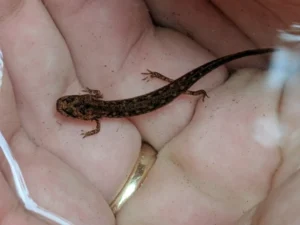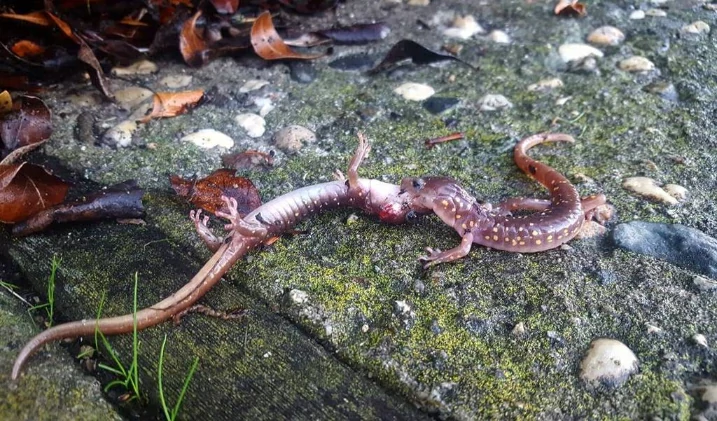Salamanders are quiet, secretive animals that often seem peaceful and shy. They move slowly, hide often, and rarely make noise. But if you’ve ever kept them in captivity or watched them closely in the wild, you might wonder, can salamanders turn on each other?
Yes, salamanders can sometimes kill each other. While they are not naturally aggressive, certain conditions like overcrowding, lack of food, or stress can cause them to fight. In some cases, this can lead to injury or death.
Why Salamanders Are Usually Peaceful
Most salamanders prefer to live alone. In the wild, they spread out and stay hidden. They do not live in groups or form social bonds. Even during mating season, their contact with others is brief.
Salamanders do not go looking for fights. They rely on avoiding danger rather than confronting it.
They use hiding, stillness, and camouflage to stay safe. Fighting takes energy and carries risks, so they only fight when they feel they must.
This peaceful behavior works well in nature, where each salamander can claim its own territory and avoid others. But in captivity or in crowded conditions, their instincts can change.
Why Fighting Happens
Salamanders usually fight for one of three reasons: space, food, or stress. When these basic needs are not met, even a calm salamander can become aggressive.
When Space Is Too Tight
Salamanders are territorial animals. Once they find a safe hiding spot or a reliable hunting area, they try to defend it. If another salamander gets too close, a fight may break out.
In the wild, this is not a problem. Salamanders can move away from each other and claim new ground.
But in a small tank or enclosed space, they cannot escape. This trapped feeling can lead to stress and fighting.
Larger salamanders are more likely to act territorial, especially when shelter is limited.
Without enough space, one salamander may dominate the area and attack others that get near.
When Food Runs Low
Salamanders eat insects, worms, and other small creatures. They are opportunistic feeders, meaning they eat whatever they can catch. When food is scarce, they may see each other as a meal.
This is especially true for young salamanders. In crowded tanks, larger larvae may eat smaller ones. This behavior is called cannibalism, and it happens more often than many people expect.
Adult salamanders may also attack smaller salamanders if they are hungry enough. It is not out of malice, but simple survival. In their eyes, a moving, smaller animal may seem like food.
When Stress Takes Over
Stress affects all animals, and salamanders are no exception. Overcrowding, poor water quality, the wrong temperature, or too much light can make them anxious. Stressed salamanders are more likely to lash out or stop eating altogether.
Even being forced to share space can cause stress. If they cannot hide or rest without disturbance, they may begin to show aggressive behaviors.
Which Salamanders Are More Aggressive?
Not all salamanders are the same. Some species are more prone to fighting or cannibalism than others.
- Tiger salamanders are one of the most aggressive species. They grow large, eat a lot, and are known to eat smaller salamanders, including their siblings.
- Mole salamanders are also territorial. They prefer to live alone and may bite others that come too close.
Smaller salamanders tend to be less aggressive, but that does not mean they are safe in groups. If a small salamander is housed with a larger one, it may still be injured or eaten.

Even peaceful species may fight under the wrong conditions. Size, hunger, and stress all affect how salamanders behave toward one another.
Warning Signs of Trouble
If you keep salamanders, it is important to watch for signs that something is wrong. Early warnings can help you take action before serious harm occurs.
Visible Injuries
Look for bite marks, missing toes, or damaged tails. These are signs that fighting has happened. Some wounds heal on their own, but others can become infected.
Sudden Behavior Changes
A salamander that hides all the time, refuses food, or avoids certain areas may be stressed or scared. If one salamander chases another or guards a corner of the tank, it may be acting territorial.
Weight Loss
A salamander that is bullied may stop eating or fail to get enough food. Over time, this can lead to weakness or death.
Skin Changes
Stressed salamanders may develop rough skin, darker colors, or dull patches. These signs should not be ignored.
By checking your salamanders daily, you can catch problems early and take steps to prevent them from getting worse.
Why This Happens Less in the Wild
In natural habitats, salamanders do not usually fight as much as they do in tanks. There are a few reasons for this.
First, wild salamanders can move freely. If they meet another salamander and feel threatened, they simply leave. There is usually enough space for everyone.

Second, food is more widely spread out. Salamanders hunt in large areas and do not have to compete over a few small prey items.
Third, they do not stay close together for long. Even during mating season, they part ways quickly. This natural distance helps reduce conflict.
In contrast, captivity creates an unnatural setting. Space is limited, food arrives all at once, and the salamanders cannot leave when stressed. These conditions raise the chance of aggression.
How to Prevent Aggression in Captivity
If you keep salamanders as pets, the best way to prevent fighting is to provide the right environment. This means enough space, plenty of food, and good care.
Use Separate Tanks
The safest choice is to keep salamanders alone. This is especially important for species known to be aggressive or if the salamanders are different sizes.
Provide Enough Hiding Places
If you house more than one salamander together, give each one its own shelter. Use logs, rocks, bark, or plants to create private spaces.
Feed Them Well
Feed salamanders regularly and in separate spots if needed. A well-fed salamander is much less likely to attack another.
Watch Closely
Check your salamanders every day. Look for signs of injury, fear, or weight loss. If one seems to be suffering, move it to its own tank.
Keep Conditions Stable
Make sure the temperature, humidity, and water quality are right for the species you have. Poor conditions increase stress, which can lead to aggression.
Should You Keep Them Together?
Some people successfully keep multiple salamanders in the same tank. But this is risky and requires careful planning. You need to:
- Choose a large enough tank
- Keep salamanders of similar size and species
- Provide many hiding spots
- Feed them well and often
- Watch for warning signs
Even then, things can go wrong. For most keepers, especially beginners, it is better to house salamanders separately.
What About Salamander Larvae?
Young salamanders are at the highest risk for cannibalism. They grow at different speeds, and the bigger ones may eat the smaller ones.

In breeding setups, it is common to separate larvae by size to prevent this. Some breeders also raise them individually.
Providing plenty of food and hiding spots helps, but it may not stop cannibalism entirely. Separation is the most reliable method.
What Happens After a Fight?
If salamanders do fight, the outcome depends on the damage done.
Minor bites may heal with time, especially if the injured salamander is moved to a clean, quiet space.
More serious wounds, like deep cuts or lost limbs, may require veterinary care. Infections can set in quickly, so wounds should be monitored closely.
A salamander that has been attacked may become fearful or stop eating. It may take time to recover, both physically and behaviorally.
Conclusion
Salamanders may look gentle and calm, and most of the time they are. But under certain conditions, they can hurt or even kill one another. These situations usually happen when space is tight, food is limited, or stress is high.
Larger species and more territorial individuals are more likely to act aggressively. Young salamanders are especially at risk due to cannibalism. But even smaller or peaceful species can fight if their needs are not met.
The good news is that most of this behavior can be avoided. By giving salamanders the right environment, enough food, and space to live alone, you can greatly reduce the risk of harm.
Salamanders are fascinating creatures, but like all animals, they have limits. Understanding those limits is key to helping them live long, healthy, and peaceful lives in captivity.
Hi, my name is Ezra Mushala, i have been interested animals all my life. I am the main author and editor here at snakeinformer.com.

